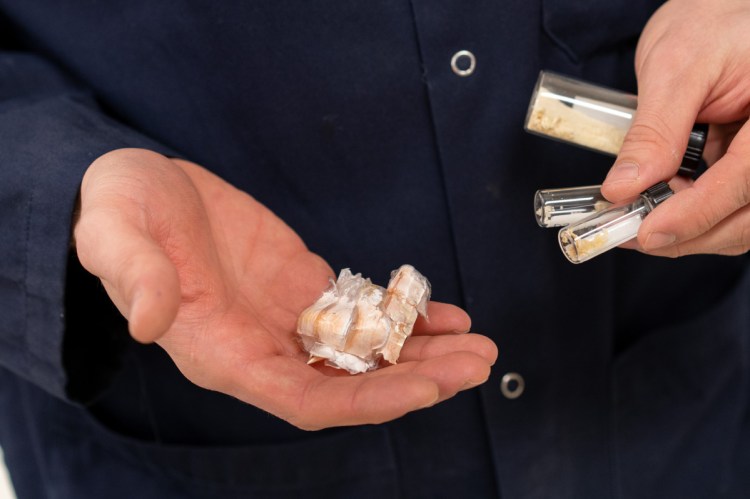A new chemical process could turn discarded lobster shells into biodegradable plastic.
Researchers at McGill University in Montreal say they have found a way to easily turn material from the shells of crustaceans and insects into plastics.
“It is completely non-toxic and generated from waste material,” said Audrey Moores, an assistant professor of chemistry at McGill. Moores and graduate student Thomas DiNardo developed the new technique.
The plastic is derived from chitin, a material from the exoskeleton of arthropods such as shrimp, lobsters, crabs and insects. If it can be commercialized, the production technique could take advantage of millions of tons of waste produced by the seafood industry every year.
“This is a material we don’t use today,” Moores said.
The McGill research follows other successful uses of chitin and a derived substance, chitosan, as plastics.

The research that Audrey Moores and Thomas DiNardo are doing involves transforming chitin into a substance called chitosan. The process cuts chains of molecules into smaller pieces so the material breaks down more quickly. Photo by Jessica Goodsell for McGill University
Recent research at the University of Georgia used chitin in flexible food packaging. Chitosan has been used in disposable medical products such as bandages, thread and stitches by scientists at Harvard University.
The McGill research is different because Moores and DiNardo have found a way to make chitosan more durable, Moores said.
“A polymer is a really long chain of molecules, like a necklace,” she said. When chitin is transformed into chitosan, that chain gets “chopped apart” so the bonds are weaker and the material breaks down more rapidly.
That is a good quality for some medical products that you want to degrade, like stitches, but not for other products.
“Now we can make a new material that is super durable,” Moores said. It could be used for food wraps, storage and surgical implants.
“It is very resilient, it is non-toxic, not going to affect the body,” Moores said. “It has a lot of biomedical applications.”
NO SPECIAL SKILLS OR HIGH-TECH LAB NEEDED
An added benefit is that the McGill process is simple – researchers mix chitosan powder with sodium hydroxide, then let the mixture age. That means it doesn’t need a high-tech laboratory or special training to produce.
“There is no big machine, no specific skills needed,” Moores said. “This is making it very appealing for large-scale application.”
Producing a chitosan polymer could tap into waste produced by the booming lobster business in Maine and Atlantic Canada.
“We are dealing with such volumes of lobster now, much of which is going to processors for value-added product,” said Rick Wahle, a marine biology professor at the University of Maine and the director of the Lobster Institute. Several years ago, the university experimented with making golf balls from lobster shells, but they did not have the distance of conventional golf balls.
Finding ways to commercialize lobster shells, other than processing them as compost, is an important research step, Wahle said.
“There are more lobster shells in the waste stream than there has ever been,” he said. “To find an application, especially as a replacement for single-use plastics, would be amazing.”
LOBSTER SHOPPING BAGS? PROBABLY NOT
Realistically, lobster-based shopping bags, drinking straws and disposable cutlery are probably not feasible. The process won’t be able to scale up enough to compete against cheap plastics produced by the massive international petrochemical industry, Moores said. That’s why her team is focusing on niche biomedical products. It will still be a few years before researchers come up with blends that will be commercially viable.
“If we start off with an application that requires too big a volume, it would put us at risk of not being able to deliver,” Moores said.
Sourcing also might be difficult. Petrochemical plastics benefit from centralized refineries, whereas the seafood industry is spread among many small producers.
“What you would need is a place to concentrate that waste and process it,” Moores said. “The East Coast of Canada or Maine is an opportunity, because you have a concentration of the industries.”
Send questions/comments to the editors.




Success. Please wait for the page to reload. If the page does not reload within 5 seconds, please refresh the page.
Enter your email and password to access comments.
Hi, to comment on stories you must . This profile is in addition to your subscription and website login.
Already have a commenting profile? .
Invalid username/password.
Please check your email to confirm and complete your registration.
Only subscribers are eligible to post comments. Please subscribe or login first for digital access. Here’s why.
Use the form below to reset your password. When you've submitted your account email, we will send an email with a reset code.